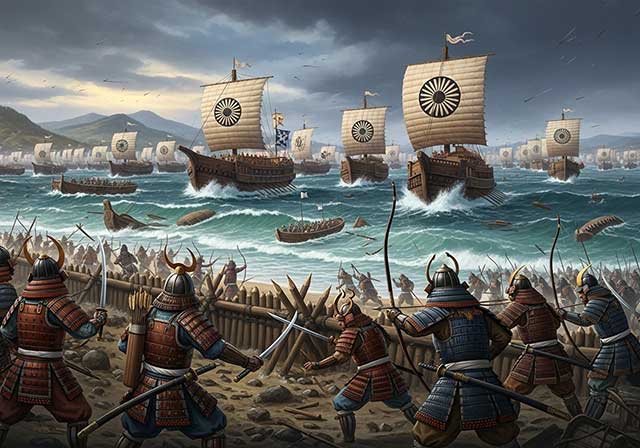
At the end of the 13th century, Japan faced a danger far more serious than any internal strife. In 1271, the Yuan dynasty, founded by Kublai Khan, grandson of Genghis Khan, established itself in China. His army was truly enormous: tens of thousands of soldiers — Chinese, Koreans, Jurchen, and especially Mongols, who had conquered the territory from Korea to Poland and from the northern taiga to Egypt. Only one country remained unconquered — Japan.
Kublai sent embassies to the imperial court with demands to recognize his authority and threats in case of refusal, but the Japanese did not respond to any of them. They knew that an attack was coming and prepared for it, although they did not realize the full power of the enemy.
The first invasion (1274)
In November 1274, Kublai's army set out for the island of Kyushu. The fleet consisted of 900 ships carrying 25,000 Mongols with horses, 10,000 Chinese, and 5,000 Koreans. In a matter of months, the Great Khan had assembled a huge army.
The Mongols easily captured the islands of Tsushima and Iki, after which they entered Hakata Bay, the only place on the northwestern coast of Kyushu suitable for a mass landing. Three coastal villages were taken, but there the invaders met fierce resistance.
There were few samurai — between 3,500 and 6,000 men. They bravely attacked the enemy, but the forces were too unequal. Many fell in battle, and the few survivors retreated under the protection of old, dilapidated fortifications. One of the warriors wrote: “All night long we mourned our fate, thinking that we were doomed and would be exterminated to the last man.”
The Mongols were cruel: in the captured villages, they killed all the men, infants, and old people, and took the women into slavery, stretching ropes through their palms cut with daggers.
However, the enemy did not advance any further. Night fell, Chinese commander Liu was wounded in battle, and the army withdrew to their ships to continue the offensive in the morning. But a storm broke out during the night. About 200 ships were wrecked on the rocks, and approximately 13,000 soldiers died at sea. The rest of the fleet returned with difficulty. The Japanese celebrated their victory and called the storm kamikaze, meaning “divine wind.”
Preparing for a new storm
Hojo Tokimune, head of the bakufu, understood that defeat would not stop Kublai Khan. The new campaign was only postponed. Only after the Mongols conquered the Song Empire did the khan begin to prepare for invasion again.
The second army was even larger. It was divided into two fleets. The eastern fleet, consisting of Mongols and Koreans, numbered 42,000 men and 900 ships. The southern fleet, according to the chronicles, included 3,500 ships and 100,000 Chinese soldiers. Although these figures are clearly exaggerated, the Mongols' superiority was absolute. Moreover, their ships were equipped with siege engines and primitive explosive bombs.
The second invasion (1281)
In May 1281, the eastern flotilla set sail. The Mongols again captured the islands of Tsushima and Iki and on June 21 approached Hakata Bay. But now the Japanese were ready: a stone wall called Genko Borui, up to 2.8 meters high, stretched along the coast for twenty kilometers. The shore was patrolled by mounted samurai.
The landing attempt was met with a hail of arrows. The Japanese fought desperately, dying but taking their enemies with them. The battles lasted several days. The Mongols burned the fortifications but were only able to land a small detachment.
Meanwhile, the samurai began to attack the ships. In fast boats, they approached the large junks, climbed aboard, and killed the crews in hand-to-hand combat. Once, thirty samurai swam to a ship, killed its crew, and returned victorious.
Another warrior, Kono Mitiari, pretended to surrender. His men hid their weapons under their clothes, boarded the enemy ship, and suddenly launched an attack. Mitiari killed the captain, captured the commander, and burned the ship.
The legendary Kusano Jiro attacked the enemy in broad daylight. Despite having his arm torn off by a cannonball, he stormed the enemy ship and personally killed 21 warriors, then set the ship on fire.
The Mongols tried to land several times, but without success. They began to wait for the Southern Fleet. But the heat, lack of water and food, unsanitary conditions, and disease killed about three thousand warriors. Morale was falling.
On August 12, the two fleets joined forces and attacked Takashima Island, intending to land in Imari Bay. The Japanese prayed to the gods for salvation.
Divine Wind
On August 16, a terrible typhoon struck. The sky turned black, and huge waves lifted and smashed ships. The Mongols had chained their ships together in advance, and now they dragged each other to the bottom.
The storm lasted three days. Almost the entire fleet was destroyed. The Mongols lost about 100,000 soldiers. The few survivors were killed by the samurai. Japan was saved.
Consequences
Kublai Khan planned another invasion, but it never took place: wars in Korea, South China, and Vietnam prevented it. From that moment until World War II, the Japanese islands remained out of reach for invaders.
See also
-
The Siege of Hara Castle

The Shimabara Rebellion of 1637–1638, which culminated in the siege of Hara Castle, was the last major uprising of the Edo period and had serious political consequences.
-
Battle of Tennoji

The confrontation between Tokugawa Ieyasu and Toyotomi Hideyori during the “Osaka Winter Campaign” ended with the signing of a peace treaty. On January 22, 1615, the day after the treaty was signed, Ieyasu pretended to disband his army. In reality, this meant that the Shimazu forces withdrew to the nearest port. On the same day, almost the entire Tokugawa army began filling in the outer moat.
-
Siege of Shuri Castle

The Ryukyu Kingdom was established in 1429 on Okinawa, the largest island of the Ryukyu (Nansei) archipelago, as a result of the military unification of three rival kingdoms. In the following years, the state's control spread to all the islands of the archipelago.
-
The Siege of Fushimi Castle
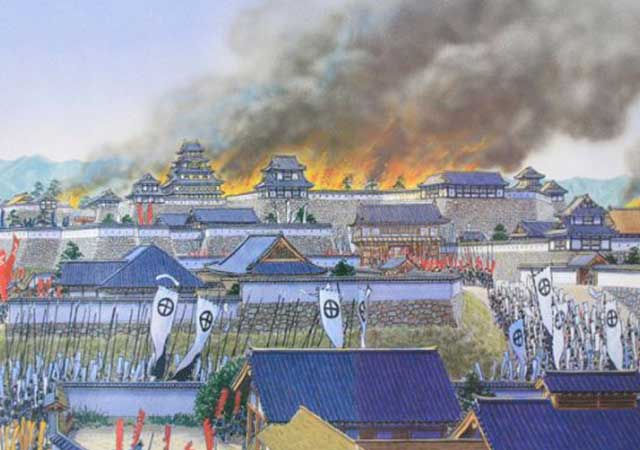
Fushimi can perhaps be considered one of the most “unfortunate” castles of the Sengoku Jidai period. The original castle was built by Toyotomi Hideyoshi in the southeast of Kyoto in 1594 as his residence in the imperial city.
-
The Siege of Otsu Castle
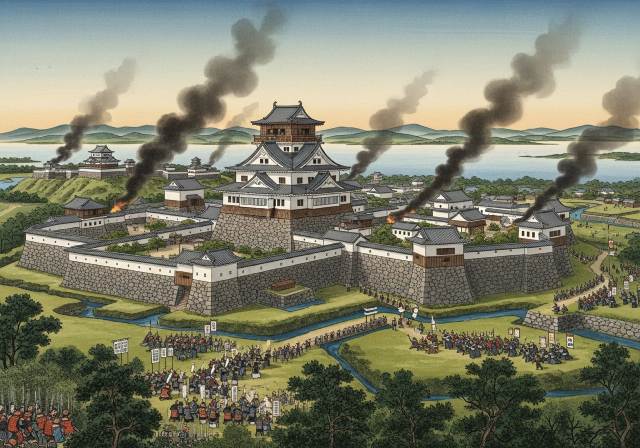
The siege of Otsu Castle was part of the Sekigahara campaign, during which the so-called Eastern Coalition, led by Tokugawa Ieyasu, fought against the Western Coalition, led by Ishida Mitsunari. Otsu Castle was built in 1586 by order of Toyotomi Hideyoshi near the capital Kyoto, on the site of the dismantled Sakamoto Castle. It belonged to the type of “water castles” — mizujō — as one side of it faced Japan's largest lake, Lake Biwa, and it was surrounded by a system of moats filled with lake water, which made the fortress resemble an island.
-
The Siege of Shiroishi Castle
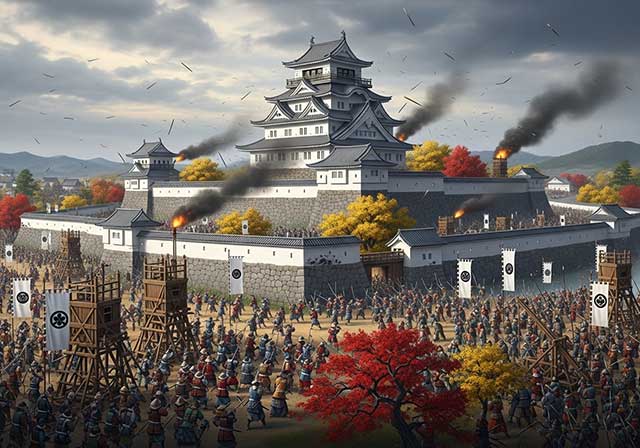
The siege of Shiroishi Castle was part of the Sekigahara campaign and took place several months before the decisive battle of Sekigahara. The daimyo of Aizu Province, Uesugi Kagekatsu, posed a serious threat to Tokugawa Ieyasu's plans to defeat the Western Coalition, and Ieyasu decided to curb his actions with the help of his northern vassals. To this end, he ordered Date Masamune to invade the province of Aizu and capture Shiroishi Castle.
-
The Second Siege of Jinju Castle
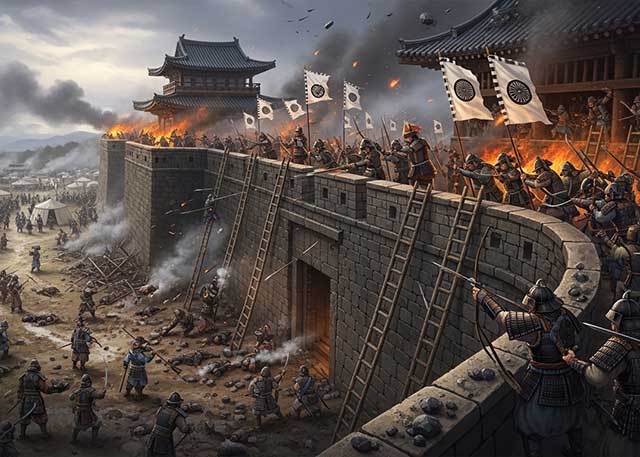
During the two Korean campaigns of the 16th century, the Japanese repeatedly had to capture enemy fortresses and defend occupied or constructed fortifications from the combined Korean and Chinese forces. Among all the operations of that time, the second siege of Jinju Castle is considered the most interesting from the point of view of siege warfare.
-
The Siege of Takamatsu Castle
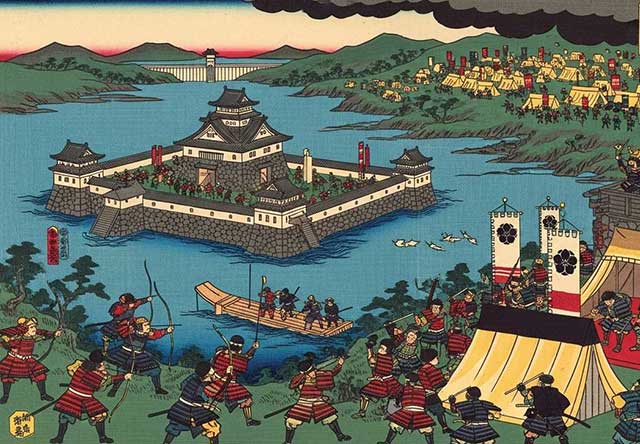
The siege of Takamatsu Castle in Bitchu Province is considered the first mizuzeme, or “water siege,” in Japanese history. Until then, such an original tactic had never been used.

